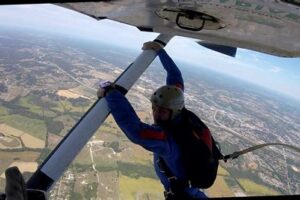Table of Contents
Curious about tandem skydiving but concerned about weight restrictions? Discover the tandem skydiving weight limit and find out if you meet the requirements. Learn about the maximum weight allowed, safety considerations, and how to prepare for an exhilarating freefall experience. Book your tandem skydive today and let the adrenaline rush take your breath away!
Tandem skydiving is an exhilarating adventure that allows individuals to experience the ultimate thrill of free-falling through the sky. However, before taking the leap and soaring through the clouds, it is important to be aware of the weight limit restrictions that come with this heart-pounding activity. Whether you are a seasoned adrenaline junkie or a first-time skydiver, understanding the tandem skydiving weight limit is crucial for a safe and enjoyable experience.
The Importance of Tandem Skydiving Weight Limit
Tandem skydiving is an exhilarating adventure that allows individuals to experience the thrill of freefalling through the sky while safely attached to an experienced instructor. However, as with any high-risk activity, there are certain limitations and restrictions in place to ensure the safety of everyone involved. One such limitation is the tandem skydiving weight limit, which plays a crucial role in maintaining the integrity of the equipment and ensuring a successful jump.
Understanding Tandem Skydiving Equipment
Before delving into the specifics of weight limits, it is essential to understand the equipment used in tandem skydiving. A typical tandem skydiving setup consists of a main parachute, a reserve parachute, and a harness system that connects the instructor and student. These components are meticulously designed and tested to ensure they can handle the forces exerted during the freefall and landing phases of the jump.
The Impact of Weight on Safety
Weight plays a crucial role in tandem skydiving safety. The combined weight of the instructor and student affects various aspects of the jump, including parachute performance, stability during freefall, and landing dynamics. Exceeding the recommended weight limits can put unnecessary strain on the equipment, potentially compromising its ability to function optimally and safely.
Typical Tandem Skydiving Weight Limits
Tandem skydiving weight limits vary depending on the drop zone and the specific equipment used. However, a common weight limit for tandem skydiving is between 200 and 220 pounds (90 to 100 kilograms). This weight limit includes the weight of both the instructor and the student. It is important to note that these limits are in place for safety reasons and exceeding them may result in the cancellation of the jump.
Reasons for Weight Restrictions
There are several reasons why weight restrictions exist in tandem skydiving:
- Equipment Limitations: The equipment used in tandem skydiving is designed to accommodate a certain weight range. Exceeding this range can compromise the integrity of the gear and increase the risk of equipment failure.
- Parachute Performance: The size and design of the parachute are optimized for a specific weight range. By staying within the recommended weight limits, the parachute can perform as intended, ensuring a safe and controlled descent.
- Freefall Stability: Weight distribution plays a vital role in maintaining stability during freefall. Proper weight balance between the instructor and student enhances maneuverability and overall control throughout the jump.
- Landing Dynamics: The landing phase of a tandem skydive requires precise control and coordination. Excessive weight can affect the landing dynamics, potentially leading to a rough or unstable landing.
The Importance of Honesty
When participating in tandem skydiving, it is essential to provide accurate information about your weight to the drop zone. Honesty about your weight ensures that the appropriate equipment and instructor are assigned to you, minimizing any potential risks associated with exceeding weight limits.
Alternative Options for Individuals Above Weight Limits
Individuals who exceed the tandem skydiving weight limits still have the opportunity to partake in the sport. Some drop zones offer specialized equipment and training for individuals with higher weights, such as tandem skydiving using a larger canopy or solo skydiving once the necessary training is completed. Exploring these alternative options allows everyone to experience the joy of skydiving safely.
Conclusion
Tandem skydiving is an incredible adventure that offers a unique perspective of the world. However, it is crucial to respect and adhere to the tandem skydiving weight limits for the safety of everyone involved. By understanding the impact of weight on equipment and following the guidelines set by drop zones, individuals can embark on this thrilling journey with confidence, knowing that their safety is a top priority.
1. Why Is There a Weight Limit for Tandem Skydiving?
The weight limit for tandem skydiving is imposed to ensure the safety of both the participants and the instructors. The parachute system, including the harness, straps, and overall design, are carefully engineered to bear a certain maximum weight. Exceeding this weight limit could compromise the equipment’s structural integrity and potentially lead to a dangerous situation during the skydive.
2. Participant Weight and Equipment Capacity
When determining the weight limit for tandem skydiving, factors such as the participant’s weight, height, and body shape are taken into consideration. The equipment capacity of the parachute system is also considered, which includes the weight-bearing capacity of the harness, the parachute canopy, and other essential components. This comprehensive assessment ensures that the equipment can safely accommodate the participants during the skydive.
3. Impact of Exceeding Weight Limit on Safety
Exceeding the weight limit for tandem skydiving can significantly impact safety. The extra weight puts additional strain on the equipment, increasing the risk of failure during deployment, landing, or any emergency procedures. Additionally, exceeding the weight limit can affect the instructor’s ability to control the freefall, alter the descent rate, and maintain stability throughout the jump, potentially compromising the overall safety of the dive.
4. Balancing Weight Restrictions and Individual Experience
While it may be disappointing for some individuals to be unable to participate in tandem skydiving due to weight restrictions, it is essential to prioritize safety. The weight limit ensures that participants can enjoy a safe and controlled skydiving experience. By adhering to these limits, skydiving centers can maintain a consistent level of safety for all participants and continue to offer this exhilarating activity to a wide range of individuals.
5. Adapting to Different Weight Limits
Different skydiving centers may have varying weight limits based on their equipment, policies, and safety standards. It is important for potential skydivers to research and choose a reputable center that specifically caters to their weight requirements. By doing so, participants can ensure that they are directed to equipment and instructors who are experienced in accommodating their specific weight range, further enhancing the safety and overall experience of the skydive.
6. Weight Restrictions and Body Mass Index (BMI)
Some skydiving centers may consider the participant’s Body Mass Index (BMI) as part of their weight limit determination. BMI takes into account an individual’s height and weight to provide a general indicator of their overall body composition. While BMI alone should not be the sole determinant of a participant’s eligibility for tandem skydiving, it can be a useful tool in conjunction with other factors, such as equipment capacity assessments, to make informed decisions regarding safety.
7. Maintaining Open Communication with Skydiving Centers
Individuals who are concerned about the weight limit for tandem skydiving should maintain open communication with the skydiving centers they are considering. By reaching out to the center’s staff, participants can discuss their specific weight concerns, ask questions about accommodations for different weight ranges, and ensure that they receive accurate and up-to-date information regarding their eligibility and safety during the skydive.
8. Encouraging a Healthy Lifestyle for Tandem Skydiving
For individuals who are determined to meet the weight limit requirements for tandem skydiving, cultivating a healthy lifestyle can be a motivating factor. Regular exercise, proper nutrition, and maintaining a healthy weight range can increase the likelihood of being eligible for the skydiving experience. Additionally, focusing on improving overall fitness levels can enhance the enjoyment and ease of the skydive, allowing participants to fully immerse themselves in this thrilling adventure.
Point of View: Tandem Skydiving Weight Limit
As a professional in the world of skydiving, it is important to address the topic of tandem skydiving weight limits. Tandem skydiving has gained immense popularity over the years, allowing thrill-seekers to experience the exhilaration of freefalling from the sky while safely attached to an experienced instructor. However, it is crucial to establish weight limits to ensure the safety and well-being of both the participant and the instructor.
The reasons for implementing weight limits in tandem skydiving are as follows:
-
Safety concerns: Tandem skydiving involves two individuals being connected by a harness system. The instructor is responsible for controlling the descent and ensuring a safe landing. Exceeding weight limits can put excessive strain on the equipment, compromising its integrity and potentially jeopardizing the safety of both participants. By implementing weight limits, we prioritize safety and minimize the risk of accidents or equipment failure.
-
Aircraft limitations: Skydiving operations utilize specific aircraft that are designed to carry a certain weight capacity. Exceeding the prescribed weight limit can exceed the aircraft’s capabilities, potentially affecting its performance and maneuverability during takeoff, flight, or landing. Adhering to weight restrictions ensures that the entire skydiving operation runs smoothly without compromising the safety of everyone involved.
-
Instructor capabilities: Tandem skydiving instructors undergo rigorous training to handle various scenarios and ensure a safe jump. However, weight distribution plays a significant role in achieving stability during freefall and landing. By adhering to weight limits, instructors can confidently control the descent, maintain stability, and execute a safe landing. This allows them to focus on providing an exceptional experience for participants without compromising their safety.
It is important to note that weight limits may vary among skydiving centers based on factors such as equipment type, weather conditions, and instructor experience. These limits are established after careful consideration of safety standards and industry guidelines.
At our skydiving center, we prioritize safety above all else. Our weight limit for tandem skydiving is set to ensure a secure and enjoyable experience for both the participant and instructor. We understand that some individuals may be disappointed if they exceed the weight limit, but it is crucial to understand that this decision is made with their well-being in mind.
In conclusion, the implementation of weight limits in tandem skydiving is essential for maintaining safety, ensuring aircraft performance, and enabling instructors to provide an exceptional experience. By adhering to these limits, we can guarantee a memorable and secure skydiving adventure for all participants while upholding the highest safety standards in the industry.
Thank you for taking the time to visit our blog and learn more about tandem skydiving weight limits. We hope that the information provided has been helpful in shedding light on this important topic. As professionals in the skydiving industry, we understand that safety is of utmost concern to both skydivers and those considering their first jump. Therefore, it is crucial to address any questions or concerns regarding weight limits to ensure the well-being and enjoyment of all participants.
Firstly, it is essential to recognize that tandem skydiving weight limits are not arbitrary restrictions put in place to exclude individuals. Rather, they are carefully calculated guidelines that take into account various factors such as equipment capabilities, instructor experience, and overall safety considerations. Skydiving harnesses and gear are designed to withstand certain weight limits, which ensures the integrity and effectiveness of the equipment during the jump. Exceeding these weight limits could compromise the safety of both the participant and the instructor, making it crucial to adhere to these guidelines.
Additionally, it is important to note that weight limits are not a reflection of an individual’s worth or physical capabilities. They are simply in place to ensure a safe and enjoyable experience for everyone involved. Skydiving instructors are trained professionals who prioritize the safety of their students above all else. By following weight limit guidelines, participants can have peace of mind knowing that they are in the hands of experienced individuals who have their best interests at heart.
In conclusion, tandem skydiving weight limits exist to maintain the highest level of safety for all participants. These limits are not meant to exclude individuals but rather to ensure that everyone can have a memorable and secure experience. By adhering to these guidelines, you can take part in the thrilling adventure of skydiving with confidence, knowing that your well-being is the top priority. We encourage you to reach out to us if you have any further questions or concerns regarding weight limits or any other aspect of tandem skydiving. Safe travels, and we hope to see you in the sky soon!
Video Tandem Skydiving Weight Limit
People also ask about Tandem Skydiving Weight Limit:
-
What is the weight limit for tandem skydiving?
The weight limit for tandem skydiving varies depending on the drop zone and the equipment used. Generally, the weight limit ranges from 200 to 240 pounds (90 to 109 kilograms). However, it’s important to check with the specific skydiving center you plan to visit, as some may have different weight restrictions.
-
Why is there a weight limit for tandem skydiving?
There is a weight limit for tandem skydiving primarily for safety reasons. The equipment used during a tandem jump is designed to support a specific weight range. Exceeding the weight limit can put excess stress on the gear and compromise its integrity, potentially leading to unsafe conditions. Additionally, a higher weight may affect the parachute’s performance and the overall experience for both the instructor and the participant.
-
Can I still go tandem skydiving if I exceed the weight limit?
Most skydiving centers adhere strictly to their weight limits for safety reasons. If you exceed the weight limit, it might not be possible to go tandem skydiving at that particular location. However, it is worth inquiring with the drop zone or considering alternative options such as AFF (Accelerated Freefall) training, which may have different weight restrictions.
-
What happens if I lie about my weight for tandem skydiving?
Lying about your weight for tandem skydiving is strongly discouraged as it poses significant safety risks. The equipment used is carefully calibrated to specific weight ranges, and providing inaccurate information can compromise the gear’s performance and jeopardize the safety of both the instructor and participant. It is essential to be honest about your weight to ensure a safe and enjoyable skydiving experience.
-
Can I request an exception to the tandem skydiving weight limit?
While it is possible to request an exception to the tandem skydiving weight limit, it is ultimately up to the discretion of the skydiving center. Some drop zones may have additional equipment or accommodations to cater to heavier individuals, but this varies from place to place. It is recommended to contact the specific skydiving center in advance to discuss your situation and inquire about any potential exceptions.






